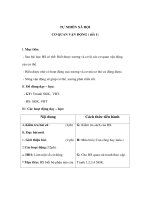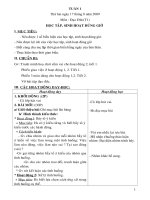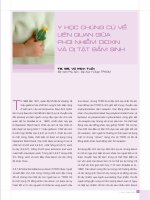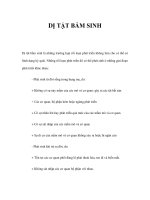Dị tật bẩm sinh cơ quan vận động
Bạn đang xem bản rút gọn của tài liệu. Xem và tải ngay bản đầy đủ của tài liệu tại đây (7.03 MB, 78 trang )
DỊ TẬT BẨM SINH
CƠ QUAN VẬN ĐỘNG
Nguyễn Thành Nhân
Mục tiêu:
Biết được sơ lược một số dị tật bẩm sinh
cơ quan vận động.
Các dị tật ở:
- Cột sống
- Chi trên
- Chi dưới
CỘT SỐNG
1. Vẹo cột sống (Scoliosis)
Forward bending test
Phân loại vẹo cột sống
King type I
Shows an S-shaped curve crossing the midline of the thoracic and lumbar curves. The lumbar curve is
larger and more rigid than the thoracic curve. The flexibility index in the bending radiographs is negative.
King type II
Shows an S-shaped curve where both the thoracic major curve and the lumbar minor curve cross over
the midline. The thoracic curve is larger.
King type III
Shows a thoracic curve where the lumbar curve does not cross the midline.
King type IV
Shows a long thoracic curve where the 5th lumbar vertebra is centered over the sacrum, but the 4th
lumbar vertebra is already angled in the direction of the curve.
King type V
Shows a thoracic double curve where the 1st thoracic vertebra (Th1) angles into the convexity of the
upper curve.
The disadvantages of the King classification system:
The sagittal profile is not included in the evaluation
So-called ”double and triple major curves” (scoliosis forms with two or three major curves) are not
considered.
King scoliosis classification is still widely used for evaluating scolioses. A number of modifications with
further subtypes have been introduced.
• In 2001, Lenke introduced a new classification system for
idiopathic scolioses which is much more complex than the
King system. Determination of the scoliosis type is based on
survey spine radiographs in 2 planes, as well as right and left
side bending radiographs with the following parameters:
• Definition of 6 curve types
The curve type is determined by the localization, degree, and
flexibility of the manifested curves. The curve apex is defined
as follows for localization purposes:
• Upper thoracic localization: Curve apex between Th2 and Th6
• Thoracic localization: Curve apex between Th6 and
intervertebral disc Th11/12
• Thoracolumbar localization: Curve apex between Th12 and
L1
• Lumbar localization: Curve apex between intervertebral disc
L1/2 and L4
• Determination of the flexibility of the curve The flexibility is
assessed either based on the residual curve in the bending
radiograph or the extent of kyphosis. A curve is defined as
structural if the bending Cobb angle exceeds 25° or the
kyphosis angle exceeds 20°.
• The following 6 curve types can be defined based on these
parameters:
• Type I (main thoracic, major curve thoracic only)
The major curve is structural, the others are not
• Type II (double thoracic, 2 thoracic curves)
The thoracic major curve and the upper thoracic minor curve are
structural; all others are non- structural.
• Type III (double major, 2 major curves)
The thoracic, thoracolumbar or lumbar curve is structural; the thoracic
curve is larger than the thoracolumbar or lumbar curve. If there is an
upper thoracic curve, it is not structural.
• Type IV (triple major, 3 major curves)
All three curves are structural; the thoracic curve is the major curve
• Type V (primary thoracolumbar/lumbar, major curve thoracolumbar or
lumbar only)
The major curve is located in the thoracic-to-lumbar transition or in
the lumbar spine and is structural; the upper thoracic or thoracic
minor curve is not structural.
• Type VI (primary thoracolumbar/lumbar, main thoracic)
The thoracolumbar or lumbar major curve is structural; the thoracic
minor curve is also structural, but its Cobb angle is at least 5°
smaller.
8t, Harrington khoâng haøn xöông
CD hàn xương
2. Bệnh Scheuermann
3. Hội chứng Klippel - Feil
CHI TRÊN
1. Thiếu chi
2. Vẹo cổ
![T]j nhiên - xã hội: CƠ QUAN VẬN ĐỘNG ( T 1 - sáng)](https://media.store123doc.com/images/document/13/pt/zq/medium_zqk1372526998.jpg)








